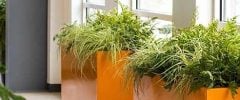Should You Grow Your Own Tropical Plants in a Greenhouse?

The costs of interior foliage, paired with the occasional limited availability, make the idea of growing your own ornamental plants a tempting option for your interiorscape business. By managing your own tropical plants, turnaround times for replacements could be mere hours instead of days. Plus, you’d eliminate shipping costs and significantly reduce the major expense of purchasing plants, potentially boosting your profits—at least theoretically.
I often dreamed of opening large industrial doors to a giant greenhouse full of dracaenas, succulents, bromeliads, palms, and all types of vines cascading from the rafters. To fulfill this dream, I relocated from the suburbs to a small town with a single streetlight, one general store, and dirt roads. I started one small hothouse, and memories from my previous experience at a commercial greenhouse resurfaced, flashing warnings like bright neon signs. However, these warnings are just part of the story. As we explore the realities of running a greenhouse, we’ll discuss both the challenges and rewards of integrating this venture into your business.
Committing to Greenhouse Management
My earliest memory is the realization that operating a greenhouse isn’t the typical Monday through Friday, nine-to-five schedule. At the time, I couldn’t understand why an automated greenhouse required around-the-clock presence. But even with automated irrigation systems, daily supervision is crucial. Whether mechanical failures or human errors, certain mishaps can devastate an entire crop in less than a day.
One such instance occurred in October, during hurricane season. I had left for the weekend and returned on Monday to find one side of my shade house destroyed, its roof caved in from the severe winds and rain. Floor plants had toppled over, branches snapped, and shelves were knocked down, leaving my tabletop tropical plants buried in two inches of mud. Although most of the foliage survived, the damage was extensive, and it would have taken months of regrowth for the plants to look good enough for client use. The cost of not having someone to supervise the shade house was steep.
Unlike servicing plants in an interiorscape account—which might only need attention weekly or bi-weekly—maintaining plants in a greenhouse is far more demanding. Giving them constant attention is quite an adjustment.
Navigating Greenhouse Challenges
From my time working in a commercial greenhouse, I’ve learned that plants in these conditions need more attention to remain healthy and thriving. One challenge is the constant exposure to light and trapped heat, which requires vigilant soil moisture monitoring. Even with adequately moist soil, certain plants—especially delicate tropical varieties with paper-like foliage—can become stressed, causing their leaves to curl or permanently droop. Also, unlike indoor plants that do well with quarterly fertilization, those in bright light structures need more frequent nutrient boosts to maintain their color and prevent them from turning pale.
Maintaining optimal conditions is only half the battle in greenhouse management. Although the spread of disease and pests is a concern in our interiorscape accounts, the risk is even greater in a greenhouse, where plants are closely packed together. Pests like fungus gnats, spider mites, and mealybugs thrive in these protected, leafy environments, making vigilant monitoring and proactive pest management essential to safeguard the health of the plants.
Operating my greenhouse is overwhelming at times, even compared to handling over fifty interiorscape accounts on my own. Having sufficient staff and budget to help with this type of horticulture project can be the difference between success and burnout. If you’re considering taking on this venture and are already pressed for time, be prepared for the significant, and often unforeseen, time commitment it demands.
Understanding Greenhouse Economics
I remember a highly successful greenhouse owner once saying, “The real expense of a greenhouse isn’t the initial purchase of the building; it’s the cost of running it.” In hot climates, fans may need to run constantly, while in cooler areas, heating bills can soar. Even with free well water, the energy cost of operating pumps is steep. In his facilities, he had backup generators and full propane tanks to prepare for power outages and to manage the cooler temperatures during winter nights. He also had a full-time maintenance worker to repair broken irrigation lines, fix faulty wiring, maintain sun panels, and address a variety of other issues to keep the facility running smoothly. As you can see, the true cost of a greenhouse is measured not by its initial setup, but by the continuous effort and resources required to sustain it effectively.
Is a Greenhouse Right for You?
Regardless of the greenhouse’s size, you will face challenges to varying extents. For this reason, many in the horticulture industry tend to stick to their specific specialties. However, understanding these hurdles can help you decide whether investing in a commercial greenhouse is a wise choice or a costly mistake. Despite these challenges, the rewards of managing a greenhouse are substantial. Growing your own tropical plants provides complete control over the growing environment. This not only ensures quality but also creates a deep sense of accomplishment as you watch your plants thrive. Additionally, having your own supply reduces long-term costs and dependence on suppliers, increasing your business’s profitability and resilience. Finally, and maybe most importantly, the ability to quickly meet client needs with high-quality plants gives you a competitive edge in the interiorscape market. So, is a greenhouse right for you?
You May Also Like
Leave a Reply
You must be logged in to post a comment.




















